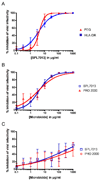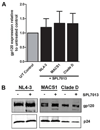Virucidal activity of the dendrimer microbicide SPL7013 against HIV-1
- PMID: 21459115
- PMCID: PMC3115201
- DOI: 10.1016/j.antiviral.2011.03.186
Virucidal activity of the dendrimer microbicide SPL7013 against HIV-1
Abstract
Topical microbicides for use by women to prevent the transmission of human immunodeficiency virus (HIV) and other sexually transmitted infections are urgently required. Dendrimers are highly branched nanoparticles being developed as microbicides. SPL7013 is a dendrimer with broad-spectrum activity against HIV type I (HIV-1) and -2 (HIV-2), herpes simplex viruses type-1 (HSV-1) and -2 (HSV-2) and human papillomavirus. SPL7013 [3% (w/w)] has been formulated in a mucoadhesive carbopol gel (VivaGel®) for use as a topical microbicide. Previous studies showed that SPL7013 has similar potency against CXCR4-(X4) and CCR5-using (R5) strains of HIV-1 and that it blocks viral entry. However, the ability of SPL7013 to directly inactivate HIV-1 is unknown. We examined whether SPL7013 demonstrates virucidal activity against X4 (NL4.3, MBC200, CMU02 clade EA and 92UG046 clade D), R5 (Ba-L, NB25 and 92RW016 clade A) and dual-tropic (R5X4; MACS1-spln) HIV-1 using a modified HLA-DR viral capture method and by polyethylene glycol precipitation. Evaluation of virion integrity was determined by ultracentrifugation through a sucrose cushion and detection of viral proteins by Western blot analysis. SPL7013 demonstrated potent virucidal activity against X4 and R5X4 strains, although virucidal activity was less potent for the 92UG046 X4 clade D isolate. Where potent virucidal activity was observed, the 50% virucidal concentrations were similar to the 50% effective concentrations previously reported in drug susceptibility assays, indicating that the main mode of action of SPL7013 is by direct viral inactivation for these strains. In contrast, SPL7013 lacked potent virucidal activity against R5 HIV-1 strains. Evaluation of the virucidal mechanism showed that SPL7013-treated NL4.3, 92UG046 and MACS1-spln virions were intact with no significant decrease in gp120 surface protein with respect to p24 capsid content compared to the corresponding untreated virus. These studies demonstrate that SPL7013 is virucidal against HIV-1 strains that utilize the CXCR4 coreceptor but not viruses tested in this study that solely use CCR5 by a mechanism that is distinct from virion disruption or loss of gp120. In addition, the mode of action by which SPL7013 prevents infection of cells with X4 and R5X4 strains is likely to differ from R5 strains of HIV-1.
Copyright © 2011 Elsevier B.V. All rights reserved.
Conflict of interest statement
GT has received funding from Starpharma Pty Ltd for contract work and consultancy. GRL and JRAP are employees of Starpharma Pty Ltd. The remaining authors declare that they have no conflicts of interest.
Figures


References
-
- Abdool Karim Q, Abdool Karim SS, Frohlich JA, Grobler AC, Baxter C, Mansoor LE, Kharsany AB, Sibeko S, Mlisana KP, Omar Z, Gengiah TN, Maarschalk S, Arulappan N, Mlotshwa M, Morris L, Taylor D. Effectiveness and safety of tenofovir gel, an antiretroviral microbicide, for the prevention of HIV infection in women. Science. 2010;329:1168–1174. - PMC - PubMed
-
- Abner SR, Guenthner PC, Guarner J, Hancock KA, Cummins JE, Jr, Fink A, Gilmore GT, Staley C, Ward A, Ali O, Binderow S, Cohen S, Grohskopf LA, Paxton L, Hart CE, Dezzutti CS. A human colorectal explant culture to evaluate topical microbicides for the prevention of HIV infection. J. Infect. Dis. 2005;192:1545–1556. - PubMed
-
- Balzarini J, Van Damme L. Microbicide drug candidates to prevent HIV infection. Lancet. 2007;369:787–797. - PubMed
-
- Bernstein DI, Stanberry LR, Sacks S, Ayisi NK, Gong YH, Ireland J, Mumper RJ, Holan G, Matthews B, McCarthy T, Bourne N. Evaluations of unformulated and formulated dendrimer-based microbicide candidates in mouse and guinea pig models of genital herpes. Antimicrob. Agents Chemother. 2003;47:3784–3788. - PMC - PubMed
-
- Brown JM, Wald A, Hubbard A, Rungruengthanakit K, Chipato T, Rugpao S, Mmiro F, Celentano DD, Salata RS, Morrison CS, Richardson BA, Padian NS. Incident and prevalent herpes simplex virus type 2 infection increases risk of HIV acquisition among women in Uganda and Zimbabwe. AIDS. 2007;21:1515–1523. - PubMed
Publication types
MeSH terms
Substances
Grants and funding
LinkOut - more resources
Full Text Sources
Other Literature Sources
Medical
Research Materials

